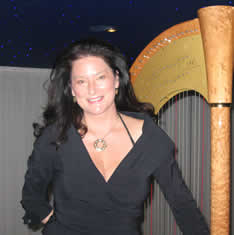Harpist Jasmin Bey Cowin Enhances Lives Through Music
By Joan Baum, Ph.D.
 |
| Harpist Jasmin Bey Cowin |
“Building Bridges,” just one of Jasmin Bey Cowin’s numerous and diverse multicultural programs for inner-city children and for older adults, having run its award-winning course, could still well describe this innovative educator’s continuing work to enrich and enhance the lives of school children and seniors by way of music. Though her career spans the humanities and the social sciences, the specialty that emerged in her adolescent years in Bretten, Germany and that remains at the center of all that she does is playing the harp.
A Fulbright scholar who studied American contemporary harp music and orchestra performance in Houston, and a former vice president of the American Harp Society, New York chapter, Dr. Cowin holds an Ed.D. from Teachers College, Columbia University where she completed a dissertation on the West German and Austrian Harp Repertoire from 1945-1990, and where she now teaches harp as a member of the adjunct faculty. She also has a Diploma for Education and Orchestral Harpist from the prestigious Staatliche Musikhochschule in Karlsruhe, Germany. She grew up in a medical environment — her father was a doctor — and she liked to read Bible stories. The passage about David soothing King Saul’s savage breast by playing the harp impressed her.
She had been studying piano since the age of six, but at 13, when she began to assist her father in his practice, she observed that the patients, many on palliative care, who visited her father and his staff were, understandably, distressed. Her father’s office was the lower floor of their home. She would help out clerically and perform minor procedures, but she also began to wonder “what more” she might do to ease the troubled souls who came to the office, particularly the elderly. She knew that even among the frail and dying, the auditory sense is the last to go. The image of David and his harp would prove influential.
Completing graduate studies in America, she began to conceive of music programs that would link seniors and school children, and that would do so where such programs were most needed – in neighborhoods that had few if any such community services in nursing homes, and in low-income, inner-city schools where youngsters were rarely exposed to music or even motivated to learn. She also worked with the Ronald McDonald House charities. And she began to include literature and history along with music in her presentations, in imaginative ways. “A Day in the Life of Tosca,” for example, describes what was going on in Rome on June 17, 1800, the day Puccini’s opera takes place.
In keeping with her sense of wanting to make a difference in music education, Dr. Cowin began to concentrate on contemporary music. “What could I do to improve the playing of Debussy,” she asked rhetorically. She could, however, make an impact by focusing on contemporaries who compose for the harp. She can only “assume” the emotional prompts of musical compositions of the past, but with contemporary music she can explore emotions with composers and discuss with audiences how those emotions are embodied in the music they hear.
A typical classroom exercise will have her asking elementary school students to write a couple of paragraphs about feelings, which she will then set to music on the harp, improvising. The students read out what they have written, and an interdisciplinary skills match has begun. How does she get around with a harp, by the way? She has a “wheelie,” she laughs.
Does it all work — if “it” is understood as engagement, quiet, being soothed? Yes, the classroom itself is evidence, she says. But does it also work, if “it” means promoting academic skills as valuable as math and science? Yes indeed, she adds, and history provides the proof. What were Pythagorean ratios but musical proportions developed and manipulated with a monochord, a sound box with one string. She also references Johannes Kepler’s music of the spheres.
A highly regarded soloist as well as co-founder of the New York Harp Duo, and first chair harpist for the New York Women’s Ensemble, Dr. Cowin still makes time to lecture, do translations of texts on music and pursue research on music therapy and music appreciation and history, including opera. She is also working toward the completion of a certificate at The Center for Modern Psychoanalytic Studies. And, oh yes, she is preparing a repertoire for a 9/11 memorial concert that will take place at a German church in Manhattan. Not incidentally, she also notes that she is the proud mother of a 10-year-old boy. #
For further information, visit www.oerlectures.com.
